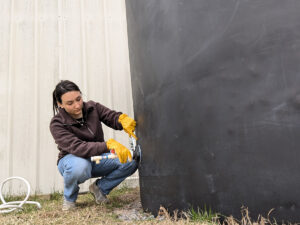News

Flooding in Kinston
After the Flood

After the devastating effects of Hurricane Matthew and the 500 year flood that followed, researchers are gathering data and assessing the current state of our waters. Early assessments estimate that North Carolina has suffered more than $1.5 billion in damage, with some areas receiving 20 inches of rain from the storm. Locally, the flood waters are receding, with some exceptions on the Neuse that have begun to pulse again due to controlled discharge from Falls Lake. Gauges on the Neuse show water levels at Goldsboro to be 9.7 feet and rising to 12 feet over the next five days, “Minor Flood” stage at Goldsboro is 17 feet. The flooding has effectively ended crab season, which usually lasts into November and sometimes even December, and most oyster beds are closed as well. NC Division of Marine Fisheries (DMF) has four teams sampling coastal waters and expects that the oyster beds will be open by mid-November, barring any more severe weather.
On Thursday, Oct 20th, the North Carolina Department of Environmental Quality issued a press release warning people to avoid contact with waters of the Neuse, Pamlico and Cape Fear rivers. During our investigations we witnessed hog waste lagoons, poultry barns and litter piles, waste water treatment facilities, gas stations, fuel storage facilities, coal ash storage ponds, automobile scrap yards, and utilities all under flood waters. Pollution from these sources can contain high levels of bacteria and waterborne viruses, toxic heavy metals, and chemicals that are harmful to humans and pets. It is also important to use extreme caution when boating, and wear a properly fitted personal flotation device at all times. High waters continue to dislodge and carry trash, logs, and other debris downriver, and much of this debris can float just below the surface and cause damage to watercraft and/or injury to boaters. To date, there is some information from DMF that no fish kills have been reported and no fish have been documented to have sores. DMF has not issued any warnings or advisories on consuming fish caught from the rivers. Also, there is no data yet to indicate if it is safe to consume crab / shrimp catch from the rivers –we strongly encourage everyone to err on the side of caution and refrain from eating any catch until sampling data has been analyzed. Sound Rivers will provide updates as we receive them.
While impossible to predict, we can look to post-Hurricane Floyd and Fran impacts for a general idea of the response likely to develop in the Neuse and Pamlico estuaries. Historically, the long term effects of hurricanes and flooding on the estuaries and Pamlico Sound can vary greatly in duration and magnitude, but following Fran and Floyd, Pamlico Sound and its estuarial tributaries showed the following conditions, and their effects:
Increased ratio of freshwater to saltwater – Salinity in Pamlico Sound decreased by 70% following Floyd. Increased freshwater input causes layers of fresh and salt water to form, trapping salt water below and reducing oxygen levels.
Low dissolved oxygen levels – Dissolved oxygen is necessary to all forms of aquatic life. Following Fran it took two months for oxygen levels to return to normal. Current data suggests oxygen levels are very low, but no fish kills have been reported.
Increased dissolved organic carbon (DOC) – DOC contributes to the growth of microorganisms, and oxygen depletion.
Decreased residency time – The time a molecule of water spends traversing Pamlico Sound was reduced from about 12 months to two months following Floyd. Pamlico Sound’s long residency time makes it particularly sensitive to nutrient loading. ;
Increased nutrient loading – Nutrients like nitrogen and phosphorus contribute to algae blooms and fish kills in estuarine systems. Hurricane Fran doubled the annual nutrient loading into Pamlico Sound and was followed by massive fish kills.
Related News

Lick Creek sampling continues
March 13th 2025

Sound Rivers Highlight: AmeriCorps Stormwater Education Coordinator Sierra Stickney
March 13th 2025

Stormwater team gets into repair business
March 13th 2025

NC Riverkeepers gather for spring meeting
March 13th 2025

Trash trap gets 33 pounds lighter
March 13th 2025

Crowd turns up for New Bern land-use ordinance workshop
March 6th 2025

Riverkeeper makes Blounts Creek benthic survey trip No. 2
March 6th 2025

Sound Rivers visits the birthplace of environmental justice
March 6th 2025


